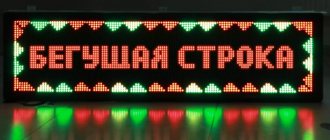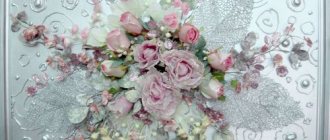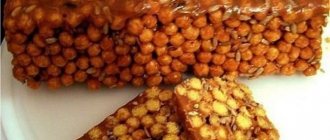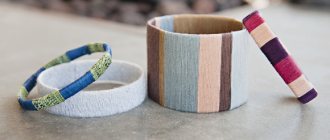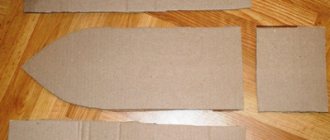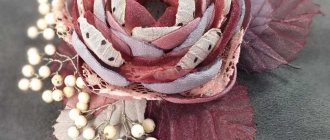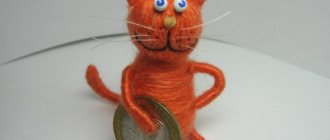Master class “Traffic officer’s baton from scrap materials”
Olga Denisova
Master class “Traffic officer’s baton from scrap materials”
Hello dear colleagues! Today I want to present you a master class on
Purpose : Attribute in the traffic rules corner.
Goals: Formation of knowledge , skills and practical habits of safe behavior on the road and street. Summarize children's knowledge about traffic rules.
For work you will need the following materials and tools:
— Electrical tape or stationery tape in two colors (black and white)
- a bubble housing in the shape of a long flask
- lace (white or black)
First, take our bubble flask and wrap it with white tape or electrical tape (I use white tape)
. I wrapped the handle with black electrical tape.
Then, using black electrical tape, we make stripes at even distances.
In the finished wand, we make two holes on the handle and thread the lace. The rod is ready .
We invite children to guess the riddle:
With this striped stick,
The policeman waves deftly. ( Rod )
Now you can play with the children, introduce the children to the fact that a traffic controller with a baton, in addition to a traffic light, can control the movement of vehicles and pedestrians. To do this, everyone needs to know certain signs given with the help of a wand . Children really like to take on the role of traffic controller .
Master class made of wood and scrap materials “The owner of the plot Glafira” Walking areas in a kindergarten can be called a testing ground for creative parents and teachers. This is where my parents are. Master class “Making a book corner from improvised materials” Dear colleagues, I would like to share with you my method of decorating a group room. Or rather, the manufacture of shelves and pockets. Making attributes for role-playing games from scrap materials together with parents Hello, dear colleagues. Preschool age is the very beginning of a child’s life, when he is just beginning to recognize himself as an individual. Massage mat made from scrap materials In ancient times, people walked barefoot on the ground and grass, which greatly improved their health. Now most people don't have the opportunity to run. Master class from acorns and artificial materials “Autumn topiary” To make topiary I needed: a foam ball, a plastic water pipe, about 20 cm long, artificial. Master class “How to quickly make a costume for a matinee in kindergarten from scrap materials. Costume “Queen Autumn” We make a costume “Queen Autumn” for a children’s party. Purpose: to show how to quickly and easily prepare a costume for a matinee in kindergarten. Master class on making a butterfly from paper and scrap materials “Beauty Butterfly” for preschool children A DIY paper butterfly is a simple craft for children, the making of which takes very little time. Experiment with sizes. Interior decoration in a kindergarten on Oseniny using natural materials at hand. Decorating the hall is 50% of the success of the holiday. The child, seeing all the beauty of the hall, better gets used to the role, thinking that he is in a fairy tale.
Source
Harry Potter's magic wand
Garik Ollivander is a character from the Harry Potter series of books. He was considered the most famous master making magic wands. Ollivander owned a shop in Diagon Alley, where he sold the magical items he made. However, to get a magic wand like Harry Potter's, you don't have to look for Diagon Alley; you can make it yourself. For this you will need the following materials:
- straight branch 26-38 cm;
- heat gun;
- acrylic paint (brown, black or white);
- a pair of brushes;
- beads or buttons for decoration;
- coarse and fine grain sandpaper.
Master class on making attributes for a role-playing game based on traffic regulations “Traffic Controller’s Rod”
Lyudmila Belousova
Master class on making attributes for a role-playing game based on traffic regulations “Traffic Controller’s Rod”
Goals: Formation of knowledge, skills and practical habits of safe behavior on the road and street. Summarize children's knowledge about traffic rules.
Tasks:
1. Introduce children to the work of a traffic controller and his signals.
2. Introduce the concept of a baton, traffic controller signals.
3. Develop attentiveness and memory.
4. Give children an idea of traffic rules and practice how to cross the road correctly.
5. Develop observation, attention, speed of reaction.
6. Foster a culture of behavior and respect for traffic rules.
Material:
rope, black electrical tape,
cling film sleeve,
Practical part.
We use a cling film sleeve, wrap it in white paper, and glue it with PVA glue. Then, using black electrical tape, we make stripes at even distances. To make the rod stronger and not get dirty, you can wrap it with transparent tape. We make two holes in the finished rod and thread the rope.
Now you can play with the children, introduce the children to the fact that a traffic controller with a baton, in addition to a traffic light, can control the movement of vehicles and pedestrians. To do this, everyone needs to know certain signs given with the help of a wand. Children really like to take on the role of traffic controller.
Master class on baking a loaf of salt dough for a role-playing game Making a loaf for children from salt dough. I needed: 4 cups of flour, 2 cups of coarse salt, 2 cups of water. Mix flour. Master class for the role-playing game “Pharmacy” in the second junior group To make the game “Pharmacy” I used: chipboard (thick cardboard can be used) 3 sheets, dimensions are determined by each individual. Master class on making attributes for the plot-role-playing game “Mail” Purpose of the game: to continue to introduce the work of the post office and postman, to consolidate the ability to correctly use some of the plot attributes.
Marking
Wood, despite its good ability to conduct energy, cannot be used without special magical signs. They should be applied neither with paint nor with a pencil, but rather cut out. To do this, you need to use the same knife that has been used all this time. Signs must be applied everywhere except the place of holding and, retreating from five to ten centimeters from the ends.
The pattern may contain Scandinavian runes, Latin inscriptions or various pentagrams and hexagrams. If you want to strengthen the staff, you can pour a little molten copper into the cracks.
DPS wands: history of appearance, modern assortment
Today, the striped traffic police baton is an integral attribute of a traffic police officer. At least in the minds of drivers and most pedestrians. It is with him that we primarily associate the employees of this police unit. It’s not surprising, since this accessory appeared even earlier than the DPS itself.
How did DPS wands come about?
The first rods designed to regulate traffic in our country were established by the mayor of St. Petersburg in 1907. Initially, the product was made only of wood, was completely white and strictly 90 cm in length. Such a rod was used by ordinary police officers, who were periodically assigned to regulate the traffic of horse-drawn vehicles in the busiest places.
In 1922, on the wave of revolutionary changes, it was decided to replace the ideologically incorrect white wands with red ones. However, in 1933 the batons were completely abolished, and traffic controllers were given white gloves. The authorities decided that it would be easier to regulate traffic with their hands. But on April 27, 1939, the baton was returned to service again, and it was then that it acquired our traditional black and white striped appearance.
Since then, the wands have remained in service continuously (with the exception of a short break in the 60s). However, by now they have seriously evolved from heavy wooden sticks into much lighter and more practical devices with built-in lighting, and often other functions.
Diagnosis of premises
While moving around the living space, you should interact with the device and visually determine the search area for geopathogenic zones. It is necessary to make marks in those places where the frame rotates counterclockwise. These points are the intersection of biopathogenic strips of land.
A vertical column appears, the diameter of which is 30 cm. It has a destructive effect on the human protective biofield: the outflow of energy necessary for life occurs. A person becomes lethargic, apathetic, and is haunted by failures and various diseases.
Crumpled aluminum foil acts as a neutralizer with high activity in hepatogenic zones.
DIY police baton made of paper
Lyudmila Belousova
Master class on making attributes for a role-playing game based on traffic regulations “Traffic Controller’s Rod”
Goals: Formation of knowledge, skills and practical habits of safe behavior on the road and street. Summarize children's knowledge about traffic rules.
Tasks:
1. Introduce children to the work of a traffic controller and his signals.
2. Introduce the concept of a baton, traffic controller signals.
3. Develop attentiveness and memory.
4. Give children an idea of traffic rules and practice how to cross the road correctly.
5. Develop observation, attention, speed of reaction.
6. Foster a culture of behavior and respect for traffic rules.
Material:
rope, black electrical tape,
cling film sleeve,
Practical part.
We use a cling film sleeve, wrap it in white paper, and glue it with PVA glue. Then, using black electrical tape, we make stripes at even distances. To make the rod stronger and not get dirty, you can wrap it with transparent tape. We make two holes in the finished rod and thread the rope.
Now you can play with the children, introduce the children to the fact that a traffic controller with a baton, in addition to a traffic light, can control the movement of vehicles and pedestrians. To do this, everyone needs to know certain signs given with the help of a wand. Children really like to take on the role of traffic controller.
Master class on baking a loaf of salt dough for a role-playing game Making a loaf for children from salt dough. I needed: 4 cups of flour, 2 cups of coarse salt, 2 cups of water. Mix flour. Master class for the role-playing game “Pharmacy” in the second junior group To make the game “Pharmacy” I used: chipboard (thick cardboard can be used) 3 sheets, dimensions are determined by each individual. Master class on making attributes for the plot-role-playing game “Mail” Purpose of the game: to continue to introduce the work of the post office, the postman, to consolidate the ability to correctly use some of the plot attributes. Master class on making a microphone for the role-playing game “Journalists” from waste material It is necessary to begin introducing children to different types of professional work from preschool age. This helps expand their understanding. Master class on making donuts for the role-playing game “Shop” Preschool children love to play role-playing games. One of my favorite games is “Shop”. Nowadays you can buy a lot for the game. Master class on making a developmental didactic manual for the plot-role-playing game “Atelier” When a child masters new plots and roles, he enriches the game with new content, and then it will remain interesting for him.
Traffic light in the form of a traffic policeman
You will need: plumbing pipe, wooden stick, acrylic varnish and paints, whistle, cap, shoulder straps, traffic cop baton, jigsaw, drill, pencil, glue. If some materials are missing, don't despair! Make a staff, a cap, and shoulder straps out of cardboard by cutting the cardboard into the desired shape.
Master Class
- Cut the pipe in half crosswise.
- Draw the character's face and traffic light circles with a simple pencil.
- Paint with paints and let them dry.
- Drill two identical holes for the arms with a drill.
- Insert the stick and glue the shoulder straps.
- Place the cap on top of the pipe.
- Hang the whistle and the baton on opposite sides.
Gestures used by traffic police officers when regulating traffic
1.1. The main stance is to stand straight, without tension, heels together, toes turned out along the front line to the width of the foot, legs straightened at the knees, but not tense, chest raised, shoulders turned (without unnecessary tension); hands freely below (right with a staff); keep your head straight; look ahead.
Stance: the right hand is raised freely in front of you, the staff is on top. In this position, the hand must be bent at the elbow joint so that the elbow is at the level of the forehead, the hand clenched into a fist, the fingers turned inward (the index and thumb are extended along the rod) and holds the rod raised vertically.
1.3. Signal "Left turn".
Stance: the right arm is extended forward, the staff is in front and is like an extension of the arm, the hand is turned down.
1.4. Signal “Traffic is allowed to move in the forward direction and turn right.”
1.4.1. Main stand.
1.4.2. Stance: arms to the sides, the thumb and index finger of the right hand are extended along the staff, the hand is turned down.
Basic provisions for an employee without a baton
2.1. The main stance is the same as with the staff.
Knitted cap and traffic police baton
Materials:
- Yarn Alize Superlana Maxi (25% wool 75% acrylic; 100 m/100 g; colors 236 and 21)
- Iris yarn in red, blue and white colors
- YarnArt Baby yarn (100% acrylic; 150m/50g; colors: 501, 585)
- Hook 3.5 mm
- Hook 1 mm
- Hook 2 mm
- Golden satin ribbon
- Golden beads (one can be split with wire cutters)
- Black polymer clay
- Cardboard
- Clear nail polish
- Wide eye needle
- Thin needle
- Transparent glue
- Holofiber
- Marker (pin)
- Tailor's pins
- Scissors
Legend:
VP – air loop RLS – single crochet PR – increase (2 stitches in one loop) UB – decrease (2 stitches knit together) SS – connecting stitch
*** The total number of loops in the row is indicated in parentheses. ***Use a marker to mark the beginning of the row.
Cap
ss, fasten the thread, cut and hide with a needle.
We attach the red thread to the top of the cap and knit the edging with connecting posts.
ss, fasten the thread and cut it, leaving the tip for sewing. Sew the cockade in the middle above the visor.
The knitted cap of a traffic police officer is ready!
